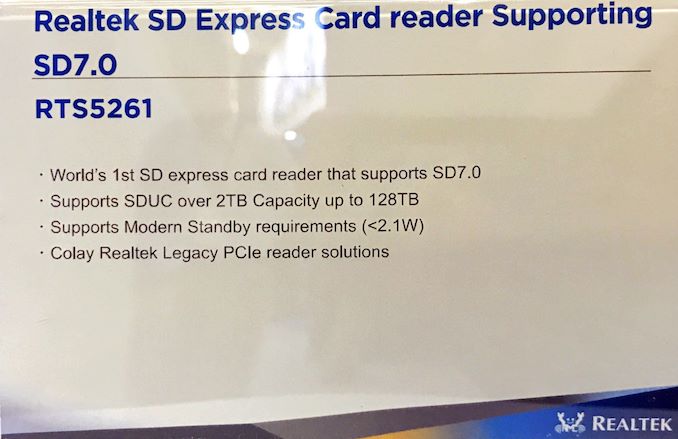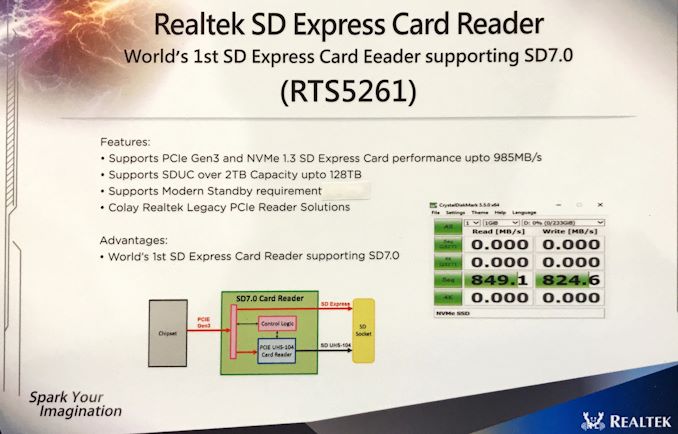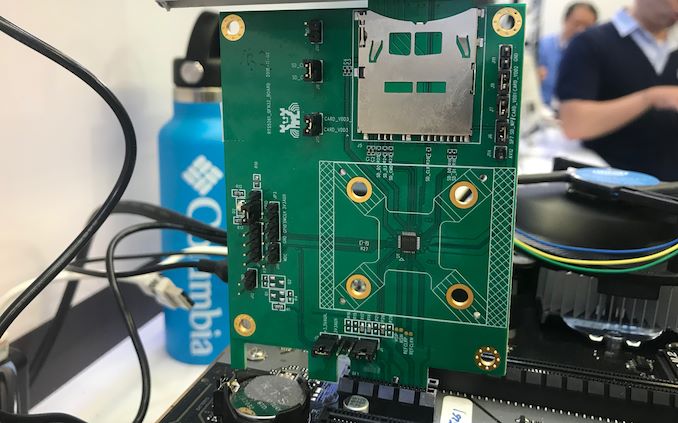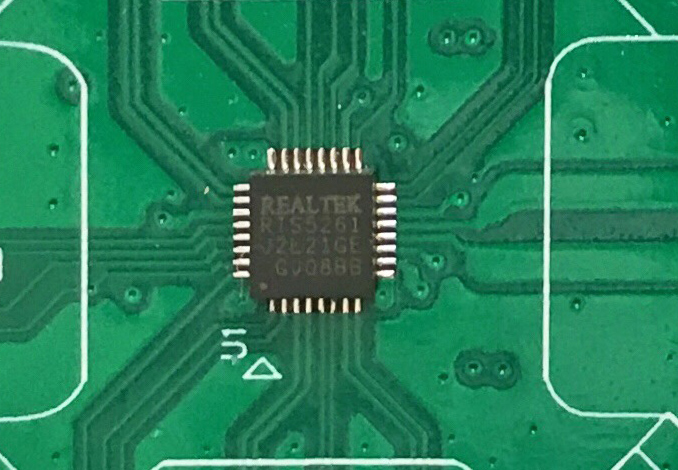Realtek Showcases RTS5261 SD Express Controller, up to 128 TB at 1GB/s
by Anton Shilov on June 14, 2019 2:00 PM EST
Last year the SD Association published its Secure Digital 7.0 standard that defines SD Express cards. At this year’s Computex, Realtek demonstrated one of the industry’s first SD Express controllers for appropriate card readers. The RTS5261 chip already exists in silicon, so it is a matter of time before it is used for actual products.
As per SD 7.0 specification, SD Express cards have to support both UHS-I as well as PCIe 3.0 x1 interfaces using different sets of pins (UHS-I for SD, UHS-II/III for PCIe). Therefore, SD 7.0 controllers have to support both protocols, legacy features of SD, capabilities of PCIe (bus mastering/DMA, command queuing, Host Memory Buffer, etc., as well as new features offered by NVMe 1.3 (e.g., power states).
Realtek’s RTS5261 supports everything mandated by the SD 7.0 specification and connects to hosts using a PCIe 3.0 interface. The controller can work with SD UC cards featuring capacities of up to 128 TB at sequential read/write speeds of up to 985 MB/s. Actual prototypes of SD Express cards from Western Digital/SanDisk seem to be slightly slower than that, yet still considerably faster when compared to existing SD UHS-II cards.
With availability of the RTS5261 controller in the near future (after it passes all the required compliance tests), developers of card readers, laptops, and other devices, can start building their products and enable infrastructure for next generation SD cards. Of course, it is going to take quite some time before SD Express takes off as a widespread standard, yet, transition of SD cards to PCIe looks inevitable.
| Want to keep up to date with all of our Computex 2019 Coverage? | ||||||
 Laptops |
 Hardware |
 Chips |
||||
| Follow AnandTech's breaking news here! | ||||||













11 Comments
View All Comments
phoenix_rizzen - Friday, June 14, 2019 - link
So, it we strapped SDUC cards to the legs of pigeons, would IP-over-Avian beat out a station wagon full of 3.5" harddrives for inter-city file transfers?PixyMisa - Friday, June 14, 2019 - link
Maybe if we strapped JATO units to the pigeons.ballsystemlord - Friday, June 14, 2019 - link
It depends on the amount of stop lights... :DAlso, you might get in trouble for animal abuse. :D
Santoval - Saturday, June 15, 2019 - link
If we talking about microSDUC cards and capacities beyond ~1 TB then hard drives should be handily beaten in capacity density. As for speed of delivery, sparrows, cats, dogs, ravens (the GoT way), various rodents or even bees and wasps could be employed along with pigeons. They all have a much smaller carbon footprint and cost, though training some of them might be a bit of a bitch.I would just like to be in the same room when someone pitched that plan to potential investors..
eastcoast_pete - Saturday, June 15, 2019 - link
Might give the "drive crapped out" a new meaning!surt - Sunday, June 16, 2019 - link
https://aws.amazon.com/snowmobile/Santoval - Saturday, June 15, 2019 - link
So still no word about IOPS I see.. I wonder if that's because the IOPS are expected to be very low (I have noticed that when IOPS are crappy SSD vendors usually "forget" to mention them) or because they're still a work in progress.PixyMisa - Saturday, June 15, 2019 - link
These are the controller chips, and IOPS will depend largely on the choice of flash. Random IO is never going to be great on these cards though.Calin - Sunday, June 16, 2019 - link
IO might be great compared to drive volume, or compared to power used - considering those are tiny compared to SSDs (both in volume and power), I expect the IOPS to reflect that discrepancy.Lolimaster - Monday, June 17, 2019 - link
That's why if you want an mSD for gaming or some apps its better to buy the A2 class models.